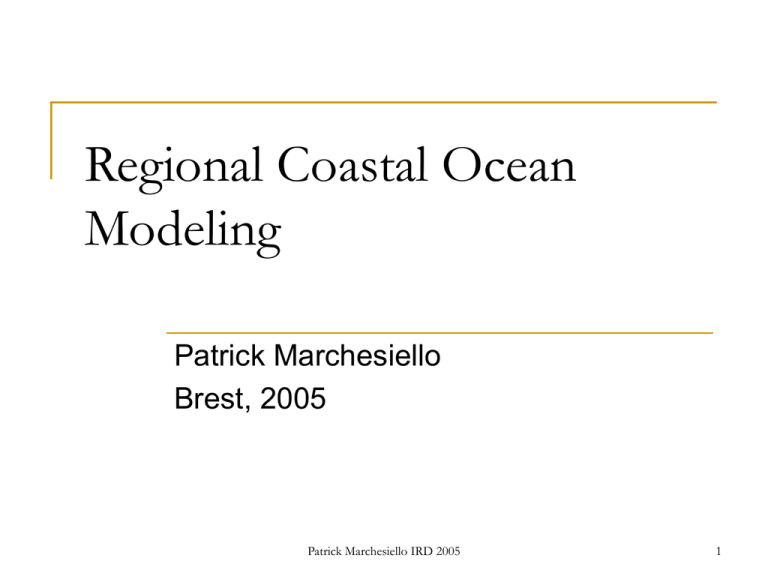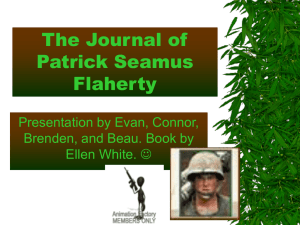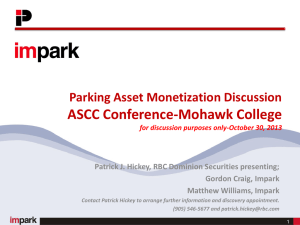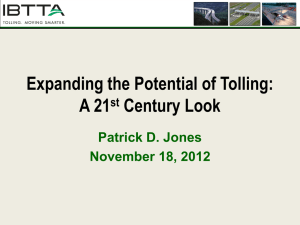Coastal Modeling
advertisement

Regional Coastal Ocean Modeling Patrick Marchesiello Brest, 2005 Patrick Marchesiello IRD 2005 1 The Coastal Ocean: A Challenging Environment Geometrical constraints: irregular coastlines and highly variable bathymetry Forcing is internal (intrinsic), lateral and superficial: tides, winds, buoyancy Broad range of space/time scales of coastal structures and dynamics: fronts, intense currents, coastal trapped waves, (sub)mesoscale variability, turbulent mixing in surface and bottom boundary layers Heterogeneity of regional and local characteristics: eastern/western boundary systems; regions can be dominated by tides, opened/closed to deep ocean Complexe Physical-biogeochemical interactions Patrick Marchesiello IRD 2005 2 Numerical Modeling Require highly optimized models of significant dynamical complexity In the past: simplified models due to limited computer resources In recent years: based on fully nonlinear stratified Primitive Equations Patrick Marchesiello IRD 2005 3 Coastal Model Inventory POM ROMS MARS3D SYMPHONIE GHERM HAMSOM QUODDY MOG3D SEOM Finite-Difference Models Finite-Elements Models Patrick Marchesiello IRD 2005 4 Patrick Marchesiello IRD 2005 5 Hydrodynamics Patrick Marchesiello IRD 2005 6 Primitive Equations: Hydrostatic, Incompressible, Boussinesq Momentum Tracer Hydrostatic Similar transport equations for other tracers: passive or actives Patrick Marchesiello IRD 2005 Continuity 7 Vertical Coordinate System Bottom following coordinate (sigma): best representation of bottom dynamics: but subject to pressure gradient errors on steep bathymetry Patrick Marchesiello IRD 2005 8 GENERALIZED -COORDINATE Stretching & condensing of vertical resolution (a) (b) (c) (d) Ts=0, Tb=0 Ts=8, Tb=0 Ts=8, Tb=1 Ts=5, Tb=0.4 Patrick Marchesiello IRD 2005 9 Horizontal Coordinate System Orthogonal curvilinear coordinates Patrick Marchesiello IRD 2005 10 Primitive Equations in Curvilinear Coordinate Patrick Marchesiello IRD 2005 11 Simplified Equations 2D barotropic 2D vertical Tidal problems Upwelling 1D vertical Turbulent mixing problems (with boundary layer parameterization) Patrick Marchesiello IRD 2005 12 Barotropic Equations Patrick Marchesiello IRD 2005 13 Vertical Problems: Parameterization of Surface and Bottom Boundary Layers Patrick Marchesiello IRD 2005 14 Boundary Layer Parameterization Boundary layers are characterized by strong turbulent mixing Turbulent Mixing depends on: Surface/bottom forcing: Wind / bottom-shear stress stirring Stable/unstable buoyancy forcing Reynolds term: w’T’ Interior conditions: Current shear instability Stratification Patrick Marchesiello IRD 2005 15 Surface and Bottom Forcing Wind stress Heat Flux Salt Flux Bottom stress Drag Coefficient CD: γ1=3.10-4 m/s Linear γ2=2.5 10-3 Quadratic Patrick Marchesiello IRD 2005 16 Boundary Layer Parameterization All mixed layer schemes are based on one-dimentional « column physics » Boundary layer parameterizations are based either on: Turbulent closure (Mellor-Yamada, TKE) K profile (KPP) Note: Hydrostatic stability may require large vertical diffusivities: implicit numerical methods are best suited. convective adjustment methods (infinite diffusivity) for explicit methods Patrick Marchesiello IRD 2005 17 Application: Tidal Fronts ROMS Simulation in the Iroise Sea (Front d’Ouessant) Simpson-Hunter criterium for tidal fronts position 1.5 < <2 H. Muller, 2004 Patrick Marchesiello IRD 2005 18 Bottom Shear Stress – Wave effect c /ln(za /z0 ) u2z z 2 w 12 f w ub2 ; a f w 1.39(ub /z0 )0.52 Waves enhance bottom shear stress (Soulsby 1995): 3.2 w cw c 1 1.2 c w Patrick Marchesiello IRD 2005 19 Numerical Discretization Patrick Marchesiello IRD 2005 20 A Discrete Ocean Patrick Marchesiello IRD 2005 21 Structured / Unstructured Grids Finite Differences / Elements Structured grids: the grid cells have the same number of sides Unstructured grids: the domain is tiled using more general geometrical shapes (triangles, …) pieced together to optimally fit details of the geometry Good for tidal modeling, engineering applications Problems: geostrophic balance accuracy, wave scattering by non-uniform grids, conservation and positivity properties, … Patrick Marchesiello IRD 2005 22 Finite Difference (Grid Point) Method If we know: The ocean state at time t (u,v,w,T,S, …) Boundary conditions (surface, bottom, lateral sides) We can compute the ocean state at t+dt using numerical approximations of Primitive Equations Patrick Marchesiello IRD 2005 23 Horizontal and Vertical Grids Patrick Marchesiello IRD 2005 24 Consistent Schemes: Taylor series expansion, truncation errors We need to find an consistent approximation for the equations derivatives Taylor series expansion of f at point x: Truncation error Patrick Marchesiello IRD 2005 25 Exemple: Advection Equation Dx Dt grid space time step Dt Dx Patrick Marchesiello IRD 2005 26 Order of Accuracy First order Downstream Upstream 2nd order Centered 4th order Patrick Marchesiello IRD 2005 27 Numerical properties: stability, dispersion/diffusion Leapfrog / Centered Tin+1 = Ti n-1 - C (Ti+1n - Ti-1n) ; C = u0 dt / dx Conditionally stable: CFL condition C < 1 but dispersive (computational modes) Euler / Centered Tin+1 = Ti n - C (Ti+1n - Ti-1n) Unconditionally unstable Upstream Tin+1 = Ti n - C (Tin - Ti-1n) , C > 0 Tin+1 = Ti n - C (Ti+1n - Tin) , C < 0 Conditionally stable, not dispersive but diffusive (monotone linear scheme) Advection equation: should be non-dispersive:the phase speed ω/k and group speed δω/δk are equal and constant (uo) Patrick Marchesiello IRD 2005 2nd order approx to the modified equation: 28 Numerical Properties A numerical scheme can be: • Dispersive: ripples, overshoot and extrema (centered) • Diffusive (upstream) • Unstable (Euler/centered) Patrick Marchesiello IRD 2005 29 Weakly Dispersive, Weakly Diffusive Schemes Using high order upstream schemes: Using a right combination of a centered scheme and a diffusive upstream scheme 3rd order upstream biased TVD, FCT, QUICK, MPDATA, UTOPIA, PPM Using flux limiters to build nolinear monotone schemes and guarantee positivity and monotonicity for tracers and avoid false extrema (FCT, TVD) Note: order of accuracy does not reduce dispersion of shorter waves Patrick Marchesiello IRD 2005 30 Upstream Centered 2nd order flux limited 3rd order flux limited Durran, 2004 Patrick Marchesiello IRD 2005 31 Accuracy Numerical dispersion 2nd order High order accurate methods: optimal choice (lower cost for a given accuracy) for general ocean circulation models is 3RD OR 4TH ORDER accurate methods (Sanderson, 1998) With special care to: • dispersion / diffusion • monotonicity and positivity • Combination of methods 4th order 2nd order double resolution Spectral method Patrick Marchesiello IRD 2005 32 Sensitivity to the Methods: Example OPA - 0.25 deg ROMS – 0.25 deg C. Blanc Patrick Marchesiello IRD 2005 C. Blanc 33 Properties of Horizontal Grids Patrick Marchesiello IRD 2005 34 Arakawa Staggered Grids Linear shallow water equation: A staggered difference is 4 times more accurate than non-staggered and improves the dispersion relation because of reduced use of averaging operators Patrick Marchesiello IRD 2005 35 Horizontal Arakawa grids B grid is prefered at coarse resolution: C grid is prefered at fine resolution: Superior for poorly resolved inertia-gravity waves. Good for Rossby waves: collocation of velocity points. Bad for gravity waves: computational checkboard mode. Superior for gravity waves. Good for well resolved inertia-gravity waves. Bad for poorly resolved waves: Rossby waves (computational checkboard mode) and inertia-gravity waves due to averaging the Coriolis force. Combinations can also be used (A + C) Patrick Marchesiello IRD 2005 36 Arakawa-C Grid Patrick Marchesiello IRD 2005 37 Vertical Staggered Grid Patrick Marchesiello IRD 2005 38 Numerical Round-off Errors Patrick Marchesiello IRD 2005 39 Round-off Errors Round-off errors result from inability of computers to represent a floating point number to infinite precision. Round-off errors tend to accumulate but little control on the magnitude of cumulative errors is possible. 1byte=8bits, ex:10100100 Simple precision machine (32-bit): 1 word=4 bytes, 6 significant digits Double precision machine (64-bit): 1 word=8 bytes, 15 significant digits Accuracy depends on word length and fractions assigned to mantissa and exponent. Double precision is possible on a machine of any given basic precision (using software instructions), but penalty is: slowdown in computation. Patrick Marchesiello IRD 2005 40 Time Stepping Patrick Marchesiello IRD 2005 41 Time Stepping: Standard Leapfrog: φin+1 = φi n-1 + 2 Δt F(φin) computational mode amplifies when applied to nonlinear equations (Burger, PE) Leapfrog + Asselin-Robert filter: φin+1 = φfi n-1 + 2 Δt F(φin) φfi n = φi n + 0.5 α (φin+1 - 2 φin + φfin-1) reduction of accuracy to 1rst order depending on α (usually 0.1) Patrick Marchesiello IRD 2005 42 Time Stepping: Performance C = 0.5 C = 0.2 Kantha and Clayson (2000) after Durran (1991) Patrick Marchesiello IRD 2005 43 Time Stepping: New Standards Multi-time level schemes: Multi-time level scheme Adams-Bashforth 3rd order (AB3) Adams-Moulton 3rd order (AM3) Multi-stage Predictor/Corrector scheme Multi-stage scheme Increase of robustness and stability range LF-Trapezoidal, LF-AM3, Forward-Backward Runge-Kutta 4: best but expensive Patrick Marchesiello IRD 2005 44 Barotropic Dynamics and Time Splitting Patrick Marchesiello IRD 2005 45 Time step restrictions The Courant-Friedrichs-Levy CFL stability condition on the barotropic (external) fast mode limits the time step: Δtext < Δx / Cext where Cext = √gH + Uemax ex: H =4000 m, Cext = 200 m/s (700 km/h) Δx = 1 km, Δtext < 5 s Baroclinic (internal) slow mode: Cin ~ 2 m/s + Uimax (internal gravity wave phase speed + max advective velocity) Δx = 1 km, Δtext < 8 mn Δtin / Δtext ~ 60-100 ! Additional diffusion and rotational conditions: Δtin < Δx2 / 2 Ah and Δtin < 1 / f Patrick Marchesiello IRD 2005 46 Barotropic Dynamics The fastest mode (barotropic) imposes a short time step 3 methods for releasing the time-step constraint: Rigid-lid approximation Implicit time-stepping Explicit time-spitting of barotropic and baroclinic modes Note: depth-averaged flow is an approximation of the fast mode (exactly true only for gravity waves in a flat bottom ocean) Patrick Marchesiello IRD 2005 47 Rigid-lid Streamfunction Method Advantage: fast mode is properly filtered Disadvantages: Preclude direct incorporation of tidal processes, storm surges, surface gravity waves. Elliptic problem to solve: convergence is difficult with complexe geometry; numerical instabilities near regions of steep slope (smoothing required) Matrix inversion (expensive for large matrices); Bad scaling properties on parallel machines Fresh water input difficult Distorts dispersion relation for Rossby waves Patrick Marchesiello IRD 2005 48 Implicit Free Surface Method Numerical damping to supress barotropic waves Disadvantanges: Not really adapted to tidal processes unless Δt is reduced, then optimality is lost Involves an elliptic problem matrix inversion Bad parallelization performances Patrick Marchesiello IRD 2005 49 Time Splitting Explicit free surface method Patrick Marchesiello IRD 2005 50 Barotropic Dynamics:Time Splitting Direct integration of barotropic equations, only few assumptions; competitive with previous methods at high resolution (avoid penalty on elliptic solver); good parallelization performances Disadvantages: potential instability issues involving difficulty of cleanly separating fast and slow modes Solution: time averaging over the barotropic sub-cycle finer mode coupling Patrick Marchesiello IRD 2005 51 Time Splitting: Averaging Averaging weights ROMS Patrick Marchesiello IRD 2005 52 Time Splitting: Coupling terms Coupling terms: advection (dispersion) + baroclinic PGF Patrick Marchesiello IRD 2005 53 Internal mode Flow Diagram of POM External mode Forcing terms of external mode Replace barotropic part in internal mode Patrick Marchesiello IRD 2005 54 Vertical Diffusion Patrick Marchesiello IRD 2005 55 Vertical Diffusion Semiimplicit CrankNicholson scheme Patrick Marchesiello IRD 2005 56 Pressure Gradient Force Patrick Marchesiello IRD 2005 57 PGF Problem Truncation errors are made from calculating the baroclinic pressure gradients across sharp topographic changes such as the continental slope Difference between 2 large terms Errors can appear in the unforced flat stratification experiment Patrick Marchesiello IRD 2005 58 Reducing PGF Truncation Errors Smoothing the topography using a nonlinear filter and a criterium: Using a density formulation Using high order schemes to reduce the truncation error (4th order, McCalpin, 1994) Gary, 1973: substracting a reference horizontal averaged value from density (ρ’= ρ - ρa) before computing pressure gradient Rewritting Equation of State: reduce passive compressibility effects on pressure gradient Patrick Marchesiello IRD 2005 r = Δh / h < 0.2 59 Equation of State Full UNESCO EOS: 30% of total CPU! Jackett & McDougall, 1995: 10% of CPU Patrick Marchesiello IRD 2005 Linearization (ROMS): reduces PGF errors 60 Smoothing methods r = Δh / h is the slope of the logarithm of h One method (ROMS) consists of smoothing ln(h) until r < rmax Res: 1 km r < 0.25 Res: 5 km r < 0.25 Senegal Bathymetry Profil Patrick Marchesiello IRD 2005 61 Smoothing method and resolution Standard Deviation [m] Bathymetry Smoothing Error off Senegal Convergence at ~ 4 km resolution Grid Resolution [deg] Patrick Marchesiello IRD 2005 62 Errors in Bathymetry data compilations Gebco1 compilation Etopo2: Satellite observations Shelf errors (noise) Patrick Marchesiello IRD 2005 63 Wetting and Drying Schemes Patrick Marchesiello IRD 2005 64 Wetting and Drying: Principles Application: Principles: mask/unmask drying/wetting areas at every time step Criterium based on a minimum depth Requirements Patrick Marchesiello IRD 2005 Intertidal zone Storm surges Conservation properties 65








